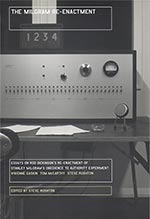The Milgram Re-enactment (2002)
The Milgram Re-enactment, 2002, Rod Dickinson in collaboration with Graeme Edler and Steve Rushton
Video Installation and installation of the laboratory / performance space comprising of electro shock equipment, tables, shelf, surveillance windows.
Total Dimensions Variable, Laboratory Dimensions: 5.5m x 3.6m x 3m
Commissioned By Vivienne Gaskin
Synopsis:
The Milgram Re-enactment is a re-enactment of Dr Stanley Milgram's infamous 1961 social psychology experiment 'Obedience to Authority'. Where participants were asked to give apparently lethal electric shocks to an unwilling victim to test how far they would be prepared to obey an authoritative scientist and inflict pain on a protesting person.
The Milgram Re-enactment was commissioned by the Centre for Contemporary Art, Glasgow , where it took place on Feb 17 2002 as a live performance. Created from transcripts of the original experiment, the re-enactment included an exact facsimile of Milgram's Yale Interaction Laboratory, and of the 1960s electro shock equipment that he used in the experiment.
The original experiment was laden with artifice (fake electric shocks, actors playing scientists, pre-recorded screams of pain), and was itself a coded re-enactment of events that took place during the holocaust. The re-enactment set up a further set of iterations through time and space; actors playing the role of actors, the repetition of the experiment as a live performance eight times in real time.
Read more about the experiment and re-enactment
The project now resides in two installations that document and extend the project:
1.A projection of the video of the performance (3hrs 40min) accompanied by 18 small framed photographs of details of the laboratory that are not visible in the film.
2. A projection of the video of the performance (3hrs 40min) accompanied by the laboratory installation that re-enactment took place in. This is a large architectural installation that includes all the electro shock equipment that was re-created for the piece. Visitors to the gallery can walk inside the installation where they can hear, but not see, the re-enactment (via speakers in the laboratory).
The video is a recording of the re-enactment in real time - during which 8 subjects move through the experiment.
The re-enactment has been exhibited over twenty times in contemporary art museums across the world (for example: ACMI (Australian Centre for the Moving Image), Melbourne, Australia and the Science Museum, London, England, Exhibition: 'Pain' 12 Feb - 20 June 2004). The performance has been written about in many art journals and the international press (for example: The Observer, Sean O'Hagan, 'It's Simply Shocking', 10 Feb, 2002, 2/3 page with photo and Art Monthly, "History will repeat itself" - February 2008 / No 313, Grayson R)
Review Snippet:
If you think this looks boring... ... just imagine watching it for two hours. Elisabeth Mahoney spends one of the longest evenings of her life at Glasgow's CCA gallery
You know the thought occurs from time to time, but it's rare to hear a cry of "Let me out! Let me out!" echoing through an art gallery. The shouting is part of the postmodern horseplay of Rod Dickinson's installation The Milgram Re-enactment, a restaging of Stanley Milgram's notorious 1961 experiment, Obedience to Authority.
The issue of obedience is inescapable, even 40 years on, and with an audience that is in on the joke. A leaflet at the CCA gallery gives strict instructions: "You will not be able to leave the space unless in the case of emergency", "Turn off your watch alarm", and "Anyone using flash photography will be asked to leave".
As you sit around the set, a freestanding four-sided structure with windows, you notice that the seats are viciously uncomfortable and that cameras are trained on the crowd. In one corner lurks a menacing amount of technical equipment and a bank of screens replaying what we see before us. A man twiddles buttons mysteriously and unravels bundles of electrical wire.
By the halfway point I'm with the guy wailing to be set free, as I contemplate a Lady Macbeth-style fainting episode and wish I had a camera with flashbulb in my bag. Rather than a sign of the project's failure, however, the creeping enervation of being here is central to its dark power. Dickinson is testing us, seeing if we'll stave off boredom, nicotine cravings, and the lure of the busy bar just beyond the gallery door, just because we've been told to stay where we are.
Milgram wanted to test whether - as his colleagues and other scientific research suggested - only a tiny, psychotic minority of volunteers would proceed with giving shocks up to 450 volts. In fact, 65% administered them, with varying - and sometimes entirely absent - moral qualms. "That doesn't put me in a very good light," beams one woman, after speeding through the punishments without pause for thought. "I don't want to injure a man for $4.50," says one man, trying to cling to some kind of moral framework but raising the question of how much he'd have to be paid.
The Guardian, Elisabeth Mahoney, Thursday February 21, 2002





